
Algae is an informal term for a large and diverse group of photosynthetic eukaryotic organisms. It is a polyphyletic grouping that includes species from multiple distinct clades. Included organisms range from unicellular microalgae, such as Chlorella, Prototheca and the diatoms, to multicellular forms, such as the giant kelp, a large brown alga which may grow up to 50 metres (160 ft) in length. Most are aquatic and autotrophic and lack many of the distinct cell and tissue types, such as stomata, xylem and phloem, which are found in land plants. The largest and most complex marine algae are called seaweeds, while the most complex freshwater forms are the Charophyta, a division of green algae which includes, for example, Spirogyra and stoneworts.

Chlorophyta or Prasinophyta is a taxon of green algae informally called chlorophytes. The name is used in two very different senses, so care is needed to determine the use by a particular author. In older classification systems, it refers to a highly paraphyletic group of all the green algae within the green plants (Viridiplantae) and thus includes about 7,000 species of mostly aquatic photosynthetic eukaryotic organisms. In newer classifications, it refers to the sister of the streptophytes/charophytes. The clade Streptophyta consists of the Charophyta in which the Embryophyta emerged. In this sense the Chlorophyta includes only about 4,300 species. About 90% of all known species live in freshwater. Like the land plants, green algae contain chlorophyll a and chlorophyll b and store food as starch in their plastids.
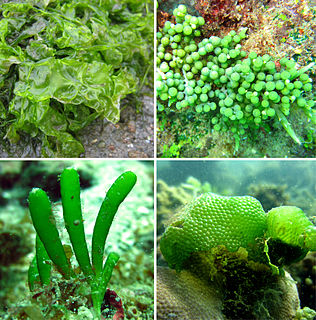
The Ulvophyceae or ulvophytes are a class of green algae, distinguished mainly on the basis of ultrastructural morphology, life cycle and molecular phylogenetic data. The sea lettuce, Ulva, belongs here. Other well-known members include Caulerpa, Codium, Acetabularia, Cladophora, Trentepohlia and Monostroma.

The plastid is a membrane-bound organelle found in the cells of plants, algae, and some other eukaryotic organisms. They are considered to be intracelluar endosymbiotic Cyanobacteria. Examples include chloroplasts, chromoplasts, and leucoplasts.
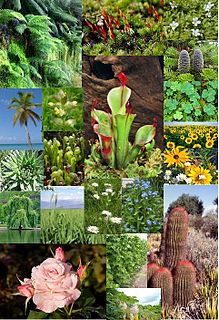
The Embryophyta or land plants are the most familiar group of green plants that form vegetation on earth. Embryophyta is a clade within the Phragmoplastophyta, a larger clade that also includes several green algae groups, and within this large clade the embryophytes are sister to the Zygnematophyceae/Mesotaeniaceae and consist of the bryophytes plus the polysporangiophytes. Living embryophytes therefore include hornworts, liverworts, mosses, ferns, lycophytes, gymnosperms and flowering plants.

The green algae are a large, informal grouping of algae consisting of the Chlorophyta and Charophyta/Streptophyta, which are now placed in separate divisions, together with the more basal Mesostigmatophyceae, Chlorokybophyceae and Spirotaenia.

Streptophyta, informally the streptophytes, is a clade of plants. The composition of the clade varies considerably between authors, but the definition employed here includes land plants and all green algae except the Chlorophyta and possibly the more basal Mesostigmatophyceae, Chlorokybophyceae, and Spirotaenia.

The Charophyta or charophytes is a group of freshwater green algae, sometimes treated as a division, but also as a superdivision, or an unranked clade. The terrestrial plants, the Embryophyta most likely emerged within Charophyta, possibly from terrestrial unicellular charophytes, with the class Zygnematophyceae as a sister group.

Plasmodesmata are microscopic channels which traverse the cell walls of plant cells and some algal cells, enabling transport and communication between them. Plasmodesmata evolved independently in several lineages, and species that have these structures include members of the Charophyceae, Charales, Coleochaetales and Phaeophyceae, as well as all embryophytes, better known as land plants. Unlike animal cells, almost every plant cell is surrounded by a polysaccharide cell wall. Neighbouring plant cells are therefore separated by a pair of cell walls and the intervening middle lamella, forming an extracellular domain known as the apoplast. Although cell walls are permeable to small soluble proteins and other solutes, plasmodesmata enable direct, regulated, symplastic transport of substances between cells. There are two forms of plasmodesmata: primary plasmodesmata, which are formed during cell division, and secondary plasmodesmata, which can form between mature cells.

Viridiplantae are a clade of eukaryotic organisms that comprise approximately 450,000–500,000 species and play important roles in both terrestrial and aquatic ecosystems. They are made up of the green algae, which are primarily aquatic, and the land plants (embryophytes), which emerged from within them. Green algae traditionally excludes the land plants, rendering them a paraphyletic group. Since the realization that the embryophytes emerged from within the green algae, some authors are starting to include them. They have cells with cellulose in their cell walls, and primary chloroplasts derived from endosymbiosis with cyanobacteria that contain chlorophylls a and b and lack phycobilins.

The Archaeplastida are a major group of eukaryotes, comprising the red algae (Rhodophyta), the green algae, and the land plants, and some smaller groups such as the glaucophytes. All of the lineages of Archaeplastida have become photoautotrophic, except for the lineage Rhodelphidia, sister to the Rhodophyta, which is still a non-photosynthetic predatorial (eukaryotrophic) flagellate. The Archaeplastida have chloroplasts that are surrounded by two membranes, suggesting that they were acquired directly through a single endosymbiosis event by feeding on a cyanobacterium. All other groups which have chloroplasts, besides the amoeboid Paulinella chromatophora, have chloroplasts surrounded by three or four membranes, suggesting they were acquired secondarily from red or green algae. Unlike red and green algae, glaucophytes have never been involved in secondary endosymbiosis events.
The Mesostigmatophyceae are a class of basal green algae found in freshwater originally containing two species in a single genus, Mesostigma. Now, a clade containing Chlorokybus and Spirotaenia has been added.. The Mesostigmatophyceae are either placed as sister to all other green algae, or more conventionally as sister to all Streptophyta.
Mesostigma viride is a species of freshwater green algae. It is now considered to be one of the earliest diverging members of green plants/algae (Viridiplantae).
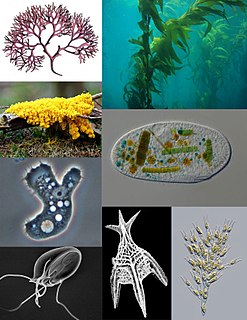
A protist is any eukaryotic organism that is not an animal, plant, or fungus. While it is likely that protists share a common ancestor, the exclusion of other eukaryotes means that protists do not form a natural group, or clade. So some protists may be more closely related to animals, plants, or fungi than they are to other protists; however, like algae, invertebrates, or protozoans, the grouping is used for convenience. The study of protists is termed protistology.

Plants are mainly multicellular organisms, predominantly photosynthetic eukaryotes of the kingdom Plantae. Historically, plants were treated as one of two kingdoms including all living things that were not animals, and all algae and fungi were treated as plants. However, all current definitions of Plantae exclude the fungi and some algae, as well as the prokaryotes. By one definition, plants form the clade Viridiplantae, a group that includes the flowering plants, conifers and other gymnosperms, ferns and their allies, hornworts, liverworts, mosses, and the green algae, but excludes the red and brown algae.
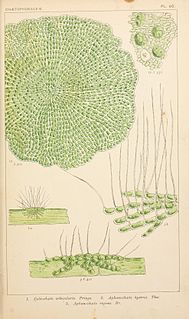
Coleochaete is a genus of parenchymatous charophyte green algae in the order Coleochaetales. They are haploid, reproduce both sexually and asexually, and have true multicellular organisation, with plasmodesmata communicating between adjacent cells. The plants form flat, sprawling discs on solid surfaces in freshwater streams worldwide, usually as epiphytes on aquatic plants or growing on the surface of stones. They are seen as one of two most probable sister groups to land plant species, the second candidate group being the Characeae. The issue is still not resolved. As they show some of the earliest and simplest features of multicellular plant growth, they are ideal model organisms in the field of synthetic biology. They are easy to culture and techniques that have been used to study Arabidopsis thaliana are now being applied to Coleochaete.
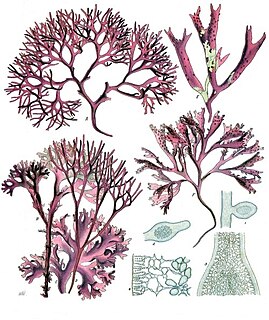
Red algae, or Rhodophyta, are one of the oldest groups of eukaryotic algae. The Rhodophyta also comprises one of the largest phyla of algae, containing over 7,000 currently recognized species with taxonomic revisions ongoing. The majority of species (6,793) are found in the Florideophyceae (class), and mostly consist of multicellular, marine algae, including many notable seaweeds. Red algae are abundant in marine habitats but are relatively rare in freshwaters. Approximately 5% of the red algae occur in freshwater environments with greater concentrations found in warmer areas. Except for two coastal cave dwelling species in the asexual class Cyanidiophyceae, there are no terrestrial species, which may be due to an evolutionary bottleneck where the last common ancestor lost about 25% of its core genes and much of its evolutionary plasticity.
Chaetosphaeridium is a genus of green algae. Although several classifications have been proposed, the bulk of the evidence supports its traditional classification in the order Coleochaetales, related to the genus Coleochaete.

The Archaeplastida+HC+SAR megagroup is a group of eukaryotes proposed by Burki et al. (2008).

Marine primary production is the chemical synthesis in the ocean of organic compounds from atmospheric or dissolved carbon dioxide. It principally occurs through the process of photosynthesis, which uses light as its source of energy, but it also occurs through chemosynthesis, which uses the oxidation or reduction of inorganic chemical compounds as its source of energy. Almost all life on Earth relies directly or indirectly on primary production. The organisms responsible for primary production are called primary producers or autotrophs.

















